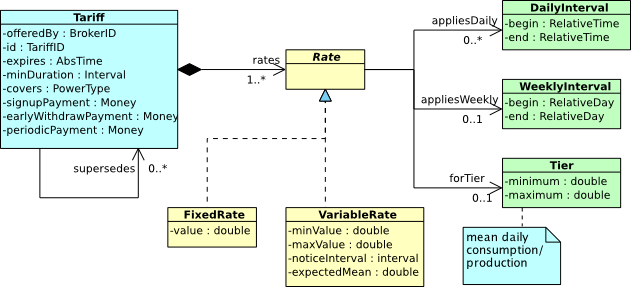Tariff Market
Contents
Tariff Market
Brokers acquire customers by offering tariff contracts. Customers are always under contract with some tariff. They will evaluate the available tariffs with respect to their own preferences, and may subscribe to one of the offered tariffs subject to the relative attractiveness compared with their current tariffs, and subject to an inertia factor that represents their general lack of attention to incoming junk mail.
Tariff representation
A Tariff is a structure composed of Rates, with applicability rules, as shown here.
This structure allows a number of features within a simple, compact object graph. The general convention is that missing elements simply do not apply. For example, a Rate without an attached Tier applies for all usage, and a Rate without any attached Daily or Weekly Intervals applies at all times. Here are some examples of tariff features that can be represented:
- Tiered rates, in which customers pay/receive one rate for a portion of usage (up to 20 kWh/day, for example), and a different rate (or set of rates) for the remainder. For example, a fixed rate could apply for the first 20 kWh/day, and another fixed rate could apply above that level on weekends, while a variable rate could apply on weekdays for the excess usage.
- Time-of-use rates would have a set of fixed rates for different intervals. The simplest form would be a night rate from perhaps 20:00 through 7:00, and a daytime rate from 7:00 through 20:00.
- Separate weekday and weekend rates.
- Two-part tariffs (fixed daily fee plus usage fee). The fixed fee is represented as the "periodicPayment" in the Tariff.
- Signup payments in either direction (fee or bonus), represented as positive or negative signupPayment values.
- Early withdrawal penalties.
- Variable rates with minimum and maximum values, estimated mean values, and notice intervals. The noticeInterval field in the variable rate is the minimum delay between a broker announcing a price change and the price change taking effect. So a noticeInterval of 2 hours would give customers at least a 2-hour notice of a price change. More specifically, for a rate with a 2-hour notice interval, the price change would take effect at the beginning of the third timeslot following the price-change announcement.
This structure does not allow a feature found in some real-world tariff examples: "Sign-up for a 6-month contract and you get the first month free," or "get 30% off for the first two months" or some other time limited rate specification."
A tariff applies to only one "Power Type" for a Customer. Power Type is a type of power consumption or production that is separately metered. Primary power types are
- Consumption: ordinary power consumption, not remotely interruptible. Customers may, of course, adapt to price variations (time-of-use or variable rates, for example) by shifting their usage with respect to their "baseline" consumption profiles.
- Interruptible consumption: power consumption that can be remotely interrupted. Typically this type of usage is connected to energy storage devices, such as water heaters or heat pumps, or even batteries. Brokers presumably induce Customers to allow interruption of their air conditioning systems by offering lower rates than they pay for ordinary consumption.
- Energy production: devices that produce power under certain conditions. Specific types of production supported in the simulation include:
- Electric vehicle: charging/discharging of electric vehicles.
Tariff lifecycle
Customer population models
Individual customer models
Initial state of the market
